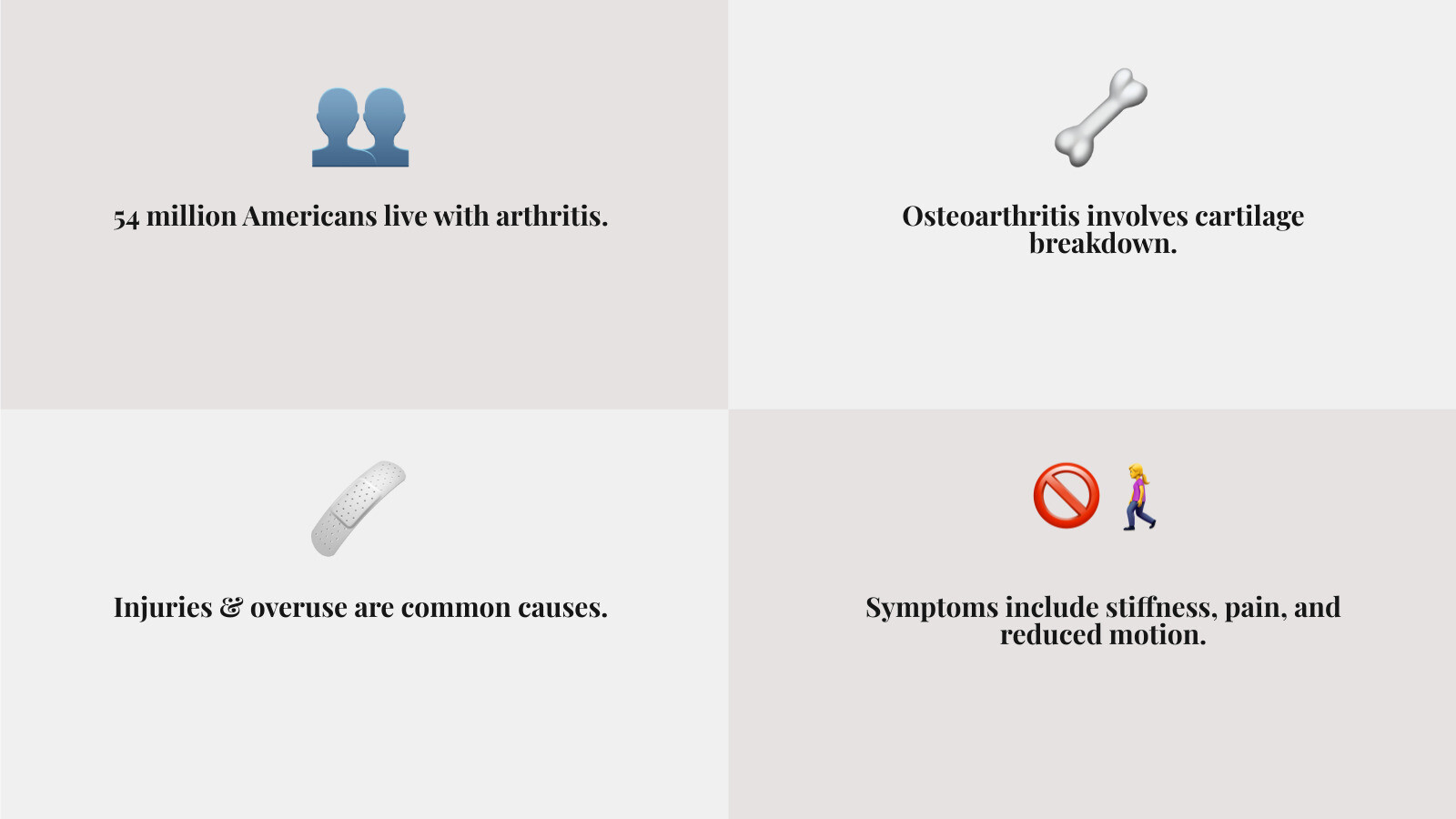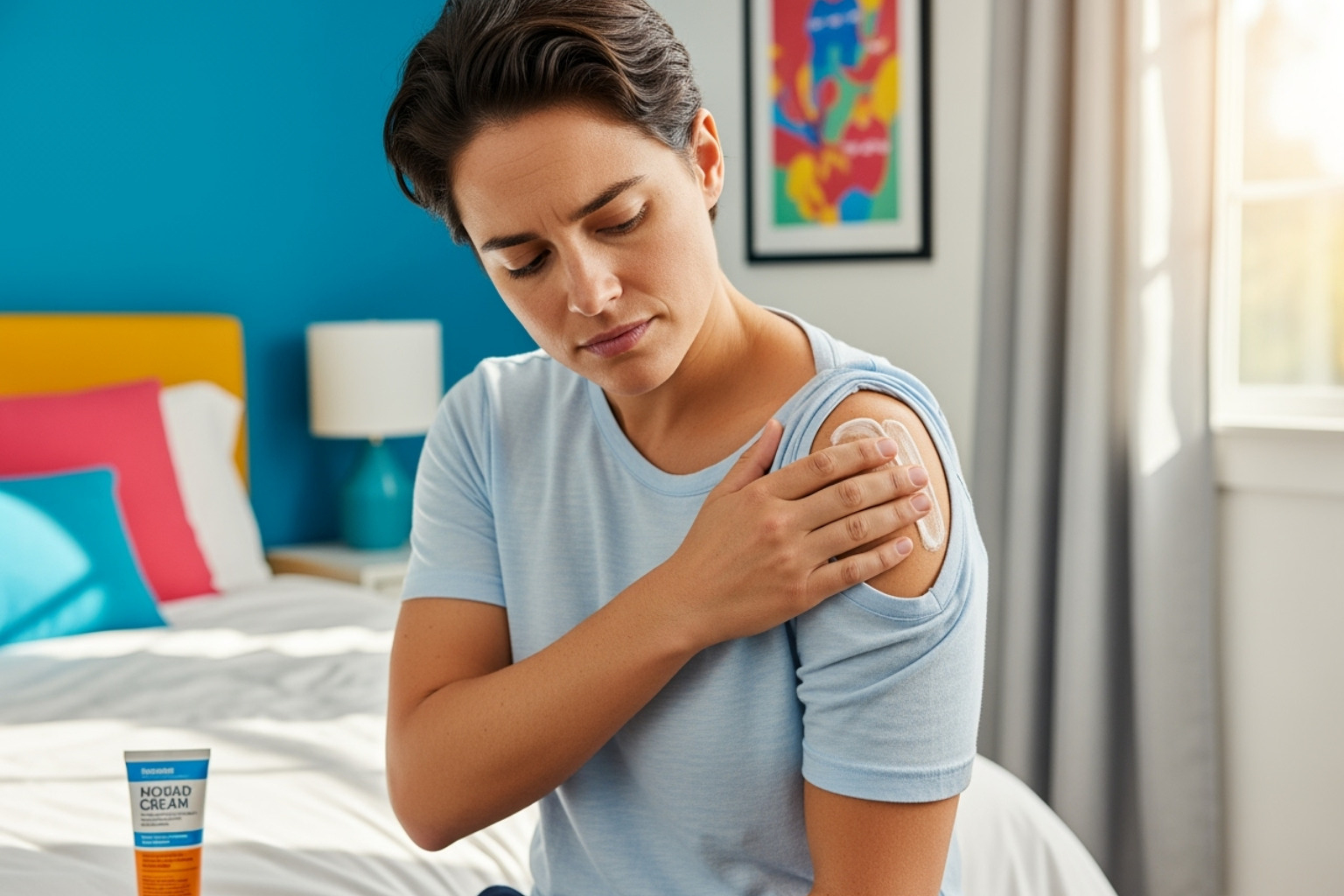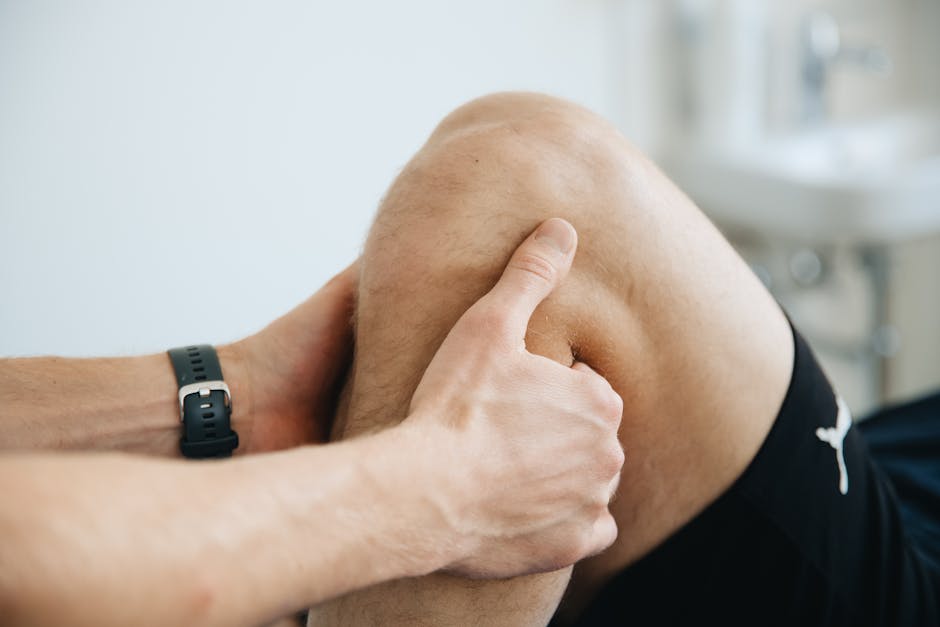Why Joint Pain Relief Matters for Your Daily Life
Joint pain relief is crucial for anyone whose discomfort limits movement, disrupts sleep, or affects their ability to work and enjoy daily activities. Whether from arthritis, injury, or age-related wear and tear, finding effective relief can transform your quality of life.
If you're looking for joint pain relief, here are the most effective approaches:
- Maintain a healthy weight - For every pound you lose, you reduce the load on your knee joint by 4 pounds
- Try topical pain relievers - Creams with menthol, capsaicin, or NSAIDs can provide targeted relief
- Use heat and cold therapy - Heat relaxes stiff muscles, cold reduces inflammation
- Stay active with low-impact exercise - Swimming, walking, and yoga strengthen supporting muscles
- Eat anti-inflammatory foods - Omega-3s, turmeric, and ginger can help reduce joint inflammation
- Consult a doctor - If pain persists, interferes with daily life, or is accompanied by fever or swelling
In the United States, 54 million people live with arthritis, and one in four experiences severe joint pain. For many, this means difficulty with simple tasks like climbing stairs. Joint pain isn't just about aging; it affects athletes, workers in physical jobs, and anyone with inflammation from conditions like bursitis or gout.
This guide will walk you through managing joint discomfort, from its causes to proven remedies. You'll learn about natural approaches, effective topical treatments, and when to see a healthcare provider.
I'm Tony Enrico. At Neuropasil, we've helped thousands find lasting joint pain relief through natural solutions that restore comfort and mobility, allowing them to reclaim the activities they love.

Handy joint pain relief terms:
Understanding Joint Pain: Causes and Symptoms
Your joints are the hinges that allow your body to move. When these intricate systems of cartilage, ligaments, and fluid are healthy, you don't notice them. But when something goes wrong, even simple movements become painful. Joint pain relief begins with understanding the cause of your discomfort, which most often affects the hands, feet, hips, knees, and spine.
Arthritis is the leading cause of disability in the U.S. and serves as an umbrella term for over 100 conditions affecting the joints.
- Osteoarthritis (OA) is the most common "wear and tear" arthritis. It occurs as the protective cartilage cushioning your bones wears away, leading to friction, pain, and stiffness. It typically appears after age 45 in weight-bearing joints like the knees and hips.
- Rheumatoid arthritis (RA) is an autoimmune disease where the immune system attacks healthy joint tissues, causing chronic inflammation, pain, and swelling. Unlike OA, it can affect people at any age and often strikes multiple joints at once.
- Gout results from sharp uric acid crystals accumulating in a joint, causing sudden, severe pain, redness, and swelling, often in the big toe.
- Bursitis is the inflammation of bursae, the small, fluid-filled sacs that cushion your joints, causing pain in areas like the hips, knees, or shoulders.
- Injuries and Overuse are also major factors. An acute injury like a sprain causes immediate pain, but even old injuries can lead to future problems. Repetitive motions from sports or work can inflame tendons and create persistent discomfort.
You can learn more about arthritis facts and statistics from the Centers for Disease Control and Prevention.
What Triggers Joint Discomfort?
Several factors contribute to joint pain. Natural wear and tear from decades of activity gradually breaks down cartilage. Once cartilage breakdown begins, bones can rub together, causing friction and pain. In conditions like RA and gout, inflammation is a primary trigger, causing swelling and warmth. In autoimmune diseases, the body's own immune system mistakenly attacks joint tissues. Finally, age increases the likelihood that these factors will become noticeable, especially after 45.
Recognizing the Signs and Symptoms
Learning to recognize your body's signals is crucial for getting the joint pain relief you need. According to medical experts at the Mayo Clinic, symptoms can vary widely but often include:
- Aching, soreness, or throbbing pain in or around the joint.
- Stiffness, especially in the morning, that improves with movement.
- Pain with movement that limits activities like walking or bending.
- A grating sensation or clicking sound when the joint moves.
- Reduced range of motion, where the joint won't move as fully as it used to.
- Swelling, redness, and warmth around the joint, which are clear signs of inflammation.
- Tenderness to the touch.
If these symptoms persist or interfere with your daily life, it's a sign to seek effective relief and prevent further damage.
Lifestyle and Home Remedies for Joint Pain Relief
Powerful tools for managing joint pain are often found in our daily choices. Simple lifestyle adjustments and home remedies can dramatically reduce discomfort and restore mobility, working together to create lasting relief.
The Role of Weight Management
Weight management is critical. For every pound you lose, you reduce the load on your knee joint by four pounds. This means losing just ten pounds takes forty pounds of pressure off your knees with every step. Excess body fat also produces inflammatory proteins called cytokines that worsen pain. Even modest weight loss of 5-10% of your body weight can bring significant joint pain relief. This progress, achieved through balanced nutrition and regular movement, can transform your daily comfort.
Diet and Nutrition for Natural Joint Pain Relief
What you eat directly impacts your joints. An anti-inflammatory diet can calm pain, while other foods can amplify it.
- Anti-inflammatory foods are your allies. Fill your plate with colorful fruits, vegetables, whole grains, and foods rich in omega-3 fatty acids like salmon, flaxseed, and walnuts. These have been shown to reduce pain and stiffness.
- Turmeric contains curcumin, a compound with powerful anti-inflammatory properties. Research shows it can be as effective as ibuprofen for knee osteoarthritis pain.
- Ginger is a natural pain reliever that blocks inflammatory compounds, similar to how NSAIDs work.
- Vitamin D, from sunlight or foods like fatty fish and egg yolks, helps the body absorb calcium to strengthen bones and may reduce arthritis risk.
Conversely, you should limit foods that cause inflammation, such as added sugars, saturated fats (in red meat and fried foods), and refined carbohydrates (like white bread). Shifting your diet is about choosing foods that support your joints more often. Our guide on Managing Arthritis Pain: A Guide to Long-Lasting Relief offers more practical strategies.
The Importance of Exercise
Though it may seem counterintuitive, regular physical activity is one of the most effective ways to achieve lasting joint pain relief. Movement produces endorphins (natural painkillers), keeps joints lubricated, and strengthens the muscles that support and stabilize your joints.
The key is choosing low-impact exercises:
- Swimming and water aerobics use water's buoyancy to take weight off your joints.
- Walking is a simple, effective way to keep joints mobile.
- Cycling provides smooth, fluid movement without high impact.
- Yoga and tai chi improve flexibility, balance, and strength while reducing stress.
Strong muscles act as shock absorbers for your joints. Start slowly and listen to your body; sharp pain is a signal to ease up. A physical therapist can help design a custom program. For more ideas, our article on Exercises for Plantar Fasciitis offers helpful guidance.
Effective Pain Management Techniques
Beyond lifestyle changes, several techniques can offer effective joint pain relief and help you manage daily discomfort. Many of these approaches can be used right at home.

Topical Solutions and OTC Medications
Topical treatments and over-the-counter (OTC) medications are often the first line of defense for mild to moderate joint pain. Creams and gels applied directly to the skin offer targeted relief. According to the Cleveland Clinic, Menthol creates a cooling sensation that distracts from pain, while Capsaicin, from chili peppers, works by depleting a chemical that transmits pain signals. Salicylates and diclofenac (an NSAID gel) also provide localized pain relief.
At Neuropasil, we've developed natural, fast-acting topical creams trusted for targeted joint pain relief. Powered by ingredients like Menthol and Aloe, our creams offer soothing relief for joint discomfort and sore muscles, and are often used by athletes for recovery. Our guide on The Ins and Outs of Best Pain Relief Creams for Muscle Pain offers more insights.
For oral OTCs, acetaminophen (Tylenol) alters the body's perception of pain, while NSAIDs like ibuprofen (Advil) and naproxen (Aleve) reduce both pain and inflammation. It's crucial to use these medications as directed, as long-term use can have side effects. Always consult a doctor before starting any new medication.
Therapeutic Approaches: Heat, Cold, and Physical Therapy
Heat and cold therapy are simple, inexpensive, and effective tools for your joint pain relief arsenal. The Mayo Clinic explains how these therapies work to ease pain.
Heat therapy (warm baths, heating pads) increases blood flow, relaxing stiff joints and muscles. It's ideal for chronic pain and morning stiffness. Cold therapy (ice packs, cold compresses) reduces inflammation and swelling by constricting blood vessels and numbing the area, making it perfect for acute injuries or flare-ups.
| Feature | Heat Therapy | Cold Therapy |
|---|---|---|
| Best For | Chronic pain, stiffness, muscle aches, preparing for activity | Acute pain, swelling, inflammation, post-activity soreness |
| How It Works | Increases blood flow, relaxes muscles, reduces stiffness | Narrows blood vessels, reduces inflammation, numbs pain |
| Duration | 15-20 minutes at a time | 10-15 minutes at a time |
Physical therapy is an invaluable resource. A physical therapist can design a personalized program to strengthen supporting muscles, improve flexibility, and teach you proper body mechanics to prevent future injury. Additionally, assistive devices like braces, canes, or orthotic shoe inserts can provide support, reduce strain, and improve stability, helping you maintain independence and protect your joints.
Medical Treatments and When to See a Doctor
While home remedies provide significant joint pain relief, professional medical intervention is sometimes necessary. Recognizing when you need more attention is key to protecting your joints and mobility.

When to Consult a Healthcare Professional
It's time to see a doctor if joint pain interferes with daily activities like sleeping, climbing stairs, or working. You should also seek immediate medical attention if your joint is hot, swollen, and red, or if the pain is accompanied by a fever, chills, or unexplained weight loss. Other red flags include numbness, tingling, or a sudden loss of motion. Persistent clicking or grinding sounds with pain also warrant a professional evaluation.
According to the CDC, early diagnosis and proper management of arthritis can significantly reduce pain and improve function. Your doctor will perform a physical exam and may order diagnostic tests like X-rays, MRI scans, or blood tests to identify the cause of your pain and determine the most effective path to relief.
Medical Treatments for Lasting Joint Pain Relief
Once a diagnosis is made, your doctor can recommend treatments that address the underlying problem. The Mayo Clinic outlines several medical options for arthritis and joint pain.
Prescription Medications: Stronger NSAIDs, disease-modifying drugs (DMARDs), biologics, or other medications like duloxetine or tramadol may be prescribed to manage severe pain and inflammation, especially for conditions like rheumatoid arthritis.
Joint Injections: Corticosteroid injections deliver powerful anti-inflammatory medication directly into a painful joint for rapid relief. For osteoarthritis, hyaluronic acid injections can improve joint lubrication and cushioning.
Physical and Occupational Therapy: A physical therapist can design an exercise program to strengthen muscles and improve range of motion. An occupational therapist can help you adapt daily tasks and recommend assistive devices to reduce joint stress.
Surgical Options: When conservative treatments fail, surgery may be an option. Joint replacement (for knees and hips) provides significant, long-lasting pain relief for most patients. Other procedures include arthroscopy (a minimally invasive repair), joint fusion (to eliminate a painful joint), or osteotomy (to realign bones and reduce pressure).
Finding the right approach often involves combining several treatments. Work closely with your healthcare team to develop a plan that restores your comfort and mobility. The Arthritis Foundation offers an excellent resource on finding the best joint pain relief for you.
Frequently Asked Questions about Joint Pain
Here are answers to some of the most common questions we hear about joint pain relief.
Can diet really help manage joint pain?
Yes. An anti-inflammatory diet can be a powerful tool. Foods rich in omega-3s (like salmon and walnuts), antioxidants (fruits and vegetables), and spices like turmeric and ginger help reduce the inflammation that causes pain. Conversely, foods high in added sugars, saturated fats, and refined carbohydrates can worsen it, as confirmed by research in the American Journal of Clinical Nutrition. By choosing foods that fight inflammation, you can actively reduce joint pain from the inside out.
What are the best exercises for someone with sore joints?
Movement is medicine, but the key is choosing low-impact activities that strengthen supporting muscles without stressing painful joints. The Arthritis Foundation highlights swimming, water aerobics, walking, and cycling as excellent choices. These activities lubricate your joints and prompt your body to produce endorphins, its own natural painkillers. Yoga and tai chi are also beneficial for improving flexibility, balance, and strength while reducing stress, which can amplify pain.
Are natural home remedies like Epsom salt baths effective?
Many people find temporary relief from warm Epsom salt soaks. While scientific evidence for the effectiveness of magnesium sulfate absorbed through the skin is limited, the Cleveland Clinic notes that the warmth acts as a form of heat therapy, increasing blood flow and relaxing the muscles around stiff, achy joints. This relaxation can ease discomfort and improve sleep. On the other hand, cold therapy (like an ice pack) is effective for acute pain and swelling, as it numbs the area and reduces inflammation. Alternating between heat and cold can address both stiffness and swelling, offering a simple, low-cost way to manage minor joint discomfort.
Conclusion
Managing your joint pain relief journey is within your control. Understanding the cause, whether it's arthritis or daily wear and tear, is the first step toward finding lasting relief. Small lifestyle changes can have a remarkable impact. Losing a few pounds, eating anti-inflammatory foods like salmon, and enjoying a gentle walk can all strengthen your body's ability to manage pain.
Day-to-day tools like heat therapy for stiffness, cold packs for swelling, and over-the-counter medications can provide comfort when you need it. For targeted, fast-acting topical relief from joint discomfort and sore muscles, many people trust natural creams like Neuropasil, which uses ingredients like Menthol and Aloe to provide soothing comfort for everything from arthritis to post-workout soreness.
If home remedies aren't enough, don't hesitate to see a healthcare provider. Advanced treatments, from prescription medications to physical therapy, can transform your quality of life. A holistic approach that combines lifestyle changes with effective treatments gives you the best chance of reclaiming the activities you love.
Don't let joint pain write your story. You deserve to move freely and live comfortably. Start with one or two manageable changes and build from there. We're here to support you. Learn more about managing pain and improving your quality of life.
Your journey to lasting joint pain relief starts today.
References
This guide draws upon information from trusted medical organizations and peer-reviewed research to provide accurate, evidence-based information for your joint pain relief journey.
American Journal of Clinical Nutrition. (2023). "Dietary-induced inflammation and its link to chronic disease." Retrieved from https://ajcn.nutrition.org/article/S0002-9165(23)04764-0/fulltext
-
Arthritis Foundation. Key resources on arthritis management, diet, and exercise:
- "What is Arthritis?" Retrieved from https://www.arthritis.org/health-wellness/about-arthritis/understanding-arthritis/what-is-arthritis
- "How Fat Affects Arthritis." Retrieved from https://www.arthritis.org/health-wellness/healthy-living/nutrition/anti-inflammatory/how-fat-affects-arthritis
- "Turmeric for Arthritis." Retrieved from https://www.arthritis.org/health-wellness/healthy-living/nutrition/anti-inflammatory/turmeric-for-arthritis
- "Best Spices for Arthritis." Retrieved from https://www.arthritis.org/health-wellness/healthy-living/nutrition/anti-inflammatory/best-spices-for-arthritis
- "Vitamin D for Arthritis." Retrieved from https://www.arthritis.org/health-wellness/healthy-living/nutrition/vitamins-minerals/vitamin-d-for-arthritis
- "12 Benefits of Exercise for Arthritis." Retrieved from https://www.arthritis.org/health-wellness/healthy-living/physical-activity/getting-started/12-benefits-of-exercise-for-arthritis
- "Finding the Best Joint Pain Relief." Retrieved from https://www.arthritis.org/health-wellness/healthy-living/managing-pain/pain-relief-solutions/finding-the-best-joint-pain-relief
-
Centers for Disease Control and Prevention (CDC). Data and management strategies for arthritis:
- "Arthritis Fact Sheet." Retrieved from https://www.cdc.gov/chronicdisease/resources/publications/factsheets/arthritis.htm
- "Arthritis Basics." Retrieved from https://www.cdc.gov/arthritis/basics/index.html
- "Arthritis Management." Retrieved from https://www.cdc.gov/arthritis/basics/management.html
-
Cleveland Clinic. Insights on lifestyle and home remedies:
- "If You Lose Weight, You Can Lose Joint Pain, Too." Retrieved from https://health.clevelandclinic.org/if-you-lose-weight-you-can-lose-joint-pain-too/
- "Do Topical Pain Relievers Really Work?" Retrieved from https://health.clevelandclinic.org/do-topical-pain-relievers-really-work
- "Do Epsom Salt Baths Actually Work?" Retrieved from https://health.clevelandclinic.org/do-epsom-salt-baths-actually-work/
-
Mayo Clinic. Information on symptoms, causes, and treatments:
- "Arthritis Symptoms and Causes." Retrieved from https://www.mayoclinic.org/diseases-conditions/arthritis/symptoms-causes/syc-20350772
- "Arthritis Diagnosis and Treatment." Retrieved from https://www.mayoclinic.org/diseases-conditions/arthritis/diagnosis-treatment/drc-20350777
- "Heat and Cold Therapy." Retrieved from https://www.mayoclinic.org/self-care-approaches/heat-and-cold-therapy/art-20457829













